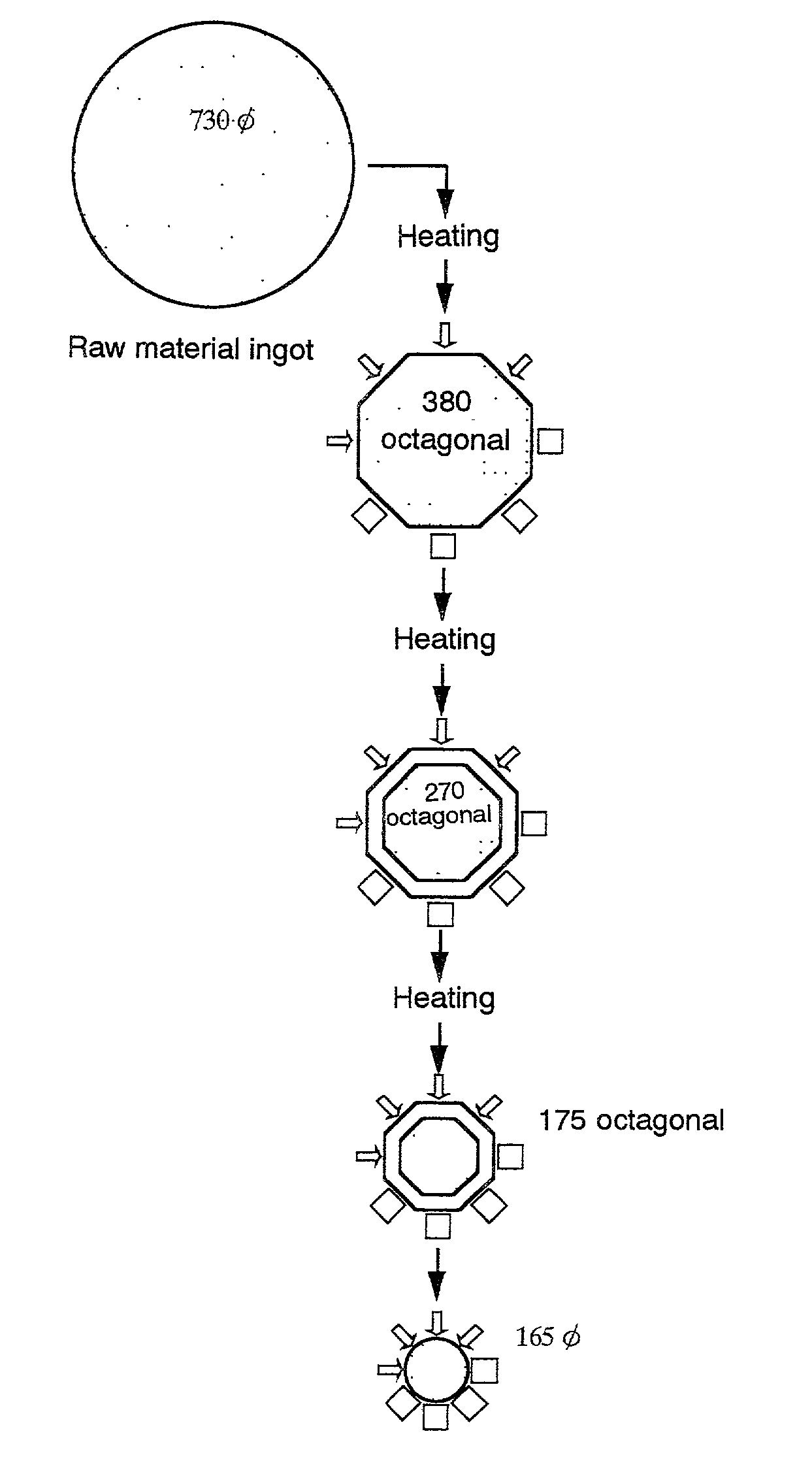Titanium material superior in upset-forgeability and method of producing the same
a technology of upset forgeability and titanium material, which is applied in the field of titanium material, can solve the problems of reducing the yield of products, affecting the quality of targets, and affecting the quality of targets, and achieves excellent upset forgeability and secure the desired upset forgeability
- Summary
- Abstract
- Description
- Claims
- Application Information
AI Technical Summary
Benefits of technology
Problems solved by technology
Method used
Image
Examples
example 1
[0048]According to the warm forging process shown in FIG. 4, a cylindrical titanium material was cogged using round molds. The starting material used was a VAR-melted ingot with a diameter of 730 mm φ x a length of 2,500 mm. In the first step, after uniform heating at 850° C. in a heating furnace, cogging was performed to 590 mm φ, to 380 mm φ in the second step, and to 280 mm φ in the third step. Then, in the fourth step, cogging was performed to the finish outside diameter of 165 mm φ using a round mold. Through the first step to the fourth step, uniform heating was conducted between steps to enable warm working at a material temperature of 850 to 500° C. The cogging works were performed while cutting the cogging, on appropriate occasions, to a length enabling easy handling in working.
[0049]The titanium material cogged to the finish outside diameter was cut to a predetermined length (e.g. 200 mm), and the cut pieces were heated at 600° C. in a heating furnace for 2 hours and then ...
example 2
[0054]According to the warm forging process shown in FIG. 5, a titanium material was worked to a cylindrical form as the final shape by cylindrical cogging using round molds in combination with square cogging using flat molds. The starting material used was the same as the one used in Example 1. In the first step, after heating at 850° C. in a heating furnace, cogging was performed to 380 mm φ using a round mold, and to 270 mm φ in the second step using a round mold. Thereafter, in the third step, square cogging was performed to 175 mm square using a flat mold. Then, in the fourth step, cogging was performed to the finish outside diameter of 165 mm φ using a round mold. Through the first step to the fourth step, uniform heating was conducted between steps to enable warm working at a material temperature of 850 to 500° C. The cogging works were performed while cutting the cogging, on appropriate occasions, to a length enabling easy handling in working.
[0055]The titanium material cogg...
example 3
[0056]According to the warm forging process shown in FIG. 6, a titanium material was worked to a cylindrical form as the final shape by performing octagonal cogging in all stages. The starting material used was the same as the one used in Example 1. In the first step, after heating at 850° C. in a heating furnace, cogging was performed to 380 mm octagonal using a flat mold, to 270 mm octagonal in the second step using a round mold, and to 175 mm octagonal in the third step using a flat mold. In the fourth step, cogging was performed to the finish outside diameter of 165 mm φ using a round mold. Through the first step to the fourth step, uniform heating was conducted between steps to enable warm working at a material temperature of 850 to 500° C. The cogging works were performed while cutting the cogging, on appropriate occasions, to a length enabling easy handling in working.
[0057]The titanium material cogged to the finish outside diameter was subjected to forging at an upsetting ra...
PUM
| Property | Measurement | Unit |
|---|---|---|
| temperature | aaaaa | aaaaa |
| diameter | aaaaa | aaaaa |
| diameter | aaaaa | aaaaa |
Abstract
Description
Claims
Application Information
 Login to View More
Login to View More - R&D
- Intellectual Property
- Life Sciences
- Materials
- Tech Scout
- Unparalleled Data Quality
- Higher Quality Content
- 60% Fewer Hallucinations
Browse by: Latest US Patents, China's latest patents, Technical Efficacy Thesaurus, Application Domain, Technology Topic, Popular Technical Reports.
© 2025 PatSnap. All rights reserved.Legal|Privacy policy|Modern Slavery Act Transparency Statement|Sitemap|About US| Contact US: help@patsnap.com



